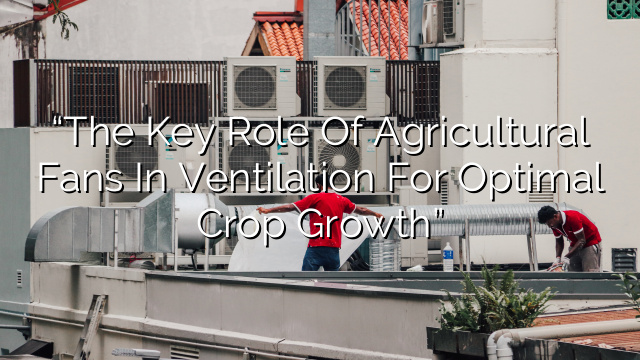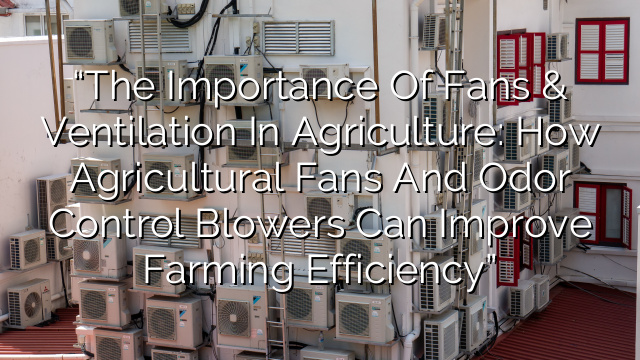Introduction
Agricultural fans play a crucial role in maintaining proper ventilation in agricultural buildings. Whether it’s a poultry house, dairy farm, or greenhouse, adequate ventilation is essential for the well-being of livestock, crops, and workers. One type of agricultural fan that is particularly effective in providing ventilation is the panel mounted wall exhaust ag fan. In this blog post, we will explore the benefits of these fans and why they are a must-have for any agricultural operation.
Improved Air Quality
One of the primary benefits of panel mounted wall exhaust ag fans is that they help improve air quality in agricultural buildings. These fans effectively remove stale air, odor, and harmful gases such as ammonia from the building, creating a healthier and more comfortable environment for both animals and workers. Proper ventilation also helps prevent the buildup of dust and other respiratory irritants, reducing the risk of respiratory diseases in livestock and improving overall productivity.
Temperature Control
Another significant advantage of panel mounted wall exhaust ag fans is their ability to control the temperature inside agricultural buildings. These fans help regulate the airflow, preventing overheating during hot summer months and ensuring proper ventilation during colder seasons. This temperature control is particularly crucial in livestock buildings where excessive heat or cold can affect animal health and productivity. With panel mounted wall exhaust ag fans, farmers can create a comfortable and optimal environment for their livestock, resulting in improved growth rates and productivity.
Energy Efficiency
Panel mounted wall exhaust ag fans are designed to be energy efficient. These fans are specifically engineered to move a large volume of air with minimum power consumption. By using these fans, farmers can effectively ventilate their agricultural buildings while keeping their energy bills low. Moreover, energy-efficient fans contribute to reducing the overall carbon footprint of the operation, making it more environmentally friendly.
Durability and Low Maintenance
Panel mounted wall exhaust ag fans are built to last. Made from high-quality materials, these fans can withstand the harsh agricultural environment, including exposure to moisture, dust, and corrosive gases. With proper installation and regular maintenance, these fans can have a long service life without significant issues. Additionally, these fans are relatively easy to maintain, requiring minimal cleaning and periodic inspection to ensure optimal performance.
Noise Reduction
While the primary function of panel mounted wall exhaust ag fans is to provide ventilation, they also help reduce noise levels in agricultural buildings. The design of these fans minimizes noise production, ensuring a quieter environment. This is particularly advantageous in agricultural operations where excessive noise can be stressful for livestock, affecting their overall well-being and productivity.
Easy Installation
Panel mounted wall exhaust ag fans are designed for easy installation. Whether you’re retrofitting an existing building or installing them in a new construction, these fans can be easily mounted on the wall. Their compact design allows for flexibility in terms of fan placement, ensuring optimal airflow throughout the building. Farmers can also select the appropriate size and number of fans based on the size and ventilation requirements of their agricultural building.
Frequently Asked Questions
- Can panel mounted wall exhaust ag fans be used in all types of agricultural buildings?
Yes, panel mounted wall exhaust ag fans can be used in various types of agricultural buildings, including poultry houses, dairy farms, greenhouses, and livestock barns. These fans are versatile and can be tailored to the specific ventilation requirements of the building.
- How do I determine the number and size of fans needed for my agricultural building?
The number and size of fans depend on several factors, including the square footage of the building, the number and type of livestock, and the specific ventilation requirements. It is recommended to consult with a ventilation expert or an agricultural engineer to determine the optimal fan configuration for your building.
- Are panel mounted wall exhaust ag fans noisy?
No, panel mounted wall exhaust ag fans are designed to minimize noise production. While they do produce some sound due to the airflow, it is generally not loud enough to cause disturbance to livestock or workers.
- Can these fans be used in conjunction with other ventilation systems?
Yes, panel mounted wall exhaust ag fans can be used in conjunction with other ventilation systems, such as circulation fans, evaporative cooling pads, or air inlets. Combining different ventilation systems can provide more precise control over airflow and temperature, ensuring optimal ventilation in the agricultural building.
- How often should panel mounted wall exhaust ag fans be cleaned and maintained?
Panel mounted wall exhaust ag fans should be cleaned and maintained regularly to ensure optimal performance. The frequency of cleaning and maintenance depends on several factors, including the environment, the presence of dust or debris, and the specific manufacturer’s recommendations. It is essential to establish a routine maintenance schedule and inspect the fans periodically for any signs of wear or damage.
In conclusion, panel mounted wall exhaust ag fans offer numerous benefits in agricultural buildings. From improving air quality and temperature control to energy efficiency and easy installation, these fans are a valuable addition to any agricultural operation. By investing in high-quality panel mounted wall exhaust ag fans and maintaining them properly, farmers can create a healthier and more productive environment for their livestock while also reducing energy costs and environmental impact.














